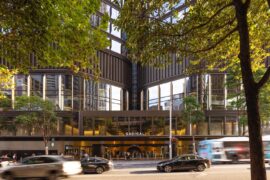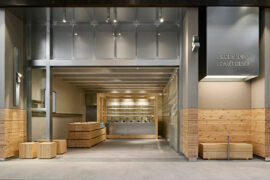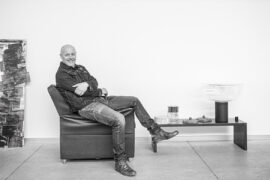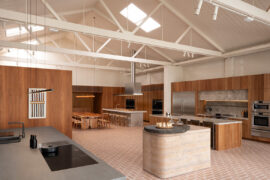We speak to architect Carol Marra following recent events focusing on climate-resilient design.

Carol Marra, photograph by Jessica Lindsay.
September 13th, 2024
Carol Marra is Co-Director of Sydney studio Marra+Yeh Architects. She recently participated in two events exploring design in relation to the climate crisis: the Climate Forum and Australian Bushfire Building Conference took place on 6th and 11-13th September, respectively. Here, Marra shares her thoughts on climate and design.
Timothy Alouani-Roby: We shouldn’t have to ask this question, but please tell us why the climate crisis is so important for you?
Carol Marra: In the late 90s I was living in the USA and about to vote for the first time in a presidential election. Al Gore’s An Inconvenient Truth was galvanising people around the topic of climate change and, as a then-young architect, I saw that we had huge potential to make a positive contribution. In the aftermath of Al’s loss to George W Bush, my husband and I moved to Sydney and started our practice shortly thereafter. We were doing a lot of work in Southeast Asia at that time and started to witness real-world impacts, like massive flash floods and wind storms. These experiences really galvanised our approach to architecture to address the impacts of climate change.
What do you think is the most important thing that designers can do in relation to climate?
We need to educate ourselves. In those early years I used to read the Intergovernmental Panel on Climate Change (IPCC) reports because we cannot have a discourse on climate change without a basic understanding of the science. We need to gather data and evidence from a wide range of reputable sources to inform how we design for and respond to climate, and we need to use this evidence as a key design criterion.
What should designers not be doing?
We need to own this issue and stop pretending it is for someone else to solve. As an advisor to government, I see so many projects where climate change impacts are addressed solely through engineering systems and architects fail to grasp the opportunities for design-led interventions, for the integration of design and engineering to create innovative and robust buildings.
What kind of power do you think the world of design and built environment has in terms of tackling the climate crisis?
We actually have a lot more power and agency than we give ourselves credit for. Design is a powerful tool to help clients understand problems, to invent multiple options and find an optimal solution – and this can happen at any scale. If we have a solid grasp of the science, the evidence, the history and the projected future, we can put options on the table that will, if nothing else, open up the conversation around climate change. I think it’s up to us to lead and not wait to be asked.
Please tell us about the two recent events you’ve been part of. What did you hope to bring to the table, and what do these kinds of gatherings achieve?
Just last week I was part of the Climate Forum, a national event to discuss these very questions around climate change, the role of the design professions, and to listen and learn from a range of people who are dedicated to change. This event was really about targeted conversations and knowledge-sharing. Having been in the climate change space for over 15 years, I concentrated on sharing my experience in practice, government and research, and giving some perspective on what has worked and where we need to focus.
This week I’ll be speaking at the Australian Bushfire Conference, this is a very targeted audience wanting to learn about bushfire resilience. I’ll be shearing lessons from my own house in the Blue Mountains, built during Black Summer and followed by three years of massive rains — and how we used that experience to refine design solutions that are resilient not only to fire but also floods, storms and heat, thinking holistically about the challenges of climate change.
Marra+Yeh Architects
marrayeh.com
More on the climate crisis and design with David Ness following COP28
INDESIGN is on instagram
Follow @indesignlive
A searchable and comprehensive guide for specifying leading products and their suppliers
Keep up to date with the latest and greatest from our industry BFF's!

Merging two hotel identities in one landmark development, Hotel Indigo and Holiday Inn Little Collins capture the spirit of Melbourne through Buchan’s narrative-driven design – elevated by GROHE’s signature craftsmanship.

Rising above the new Sydney Metro Gadigal Station on Pitt Street, Investa’s Parkline Place is redefining the office property aesthetic.

London-based design duo Raw Edges have joined forces with Established & Sons and Tongue & Groove to introduce Wall to Wall – a hand-stained, “living collection” that transforms parquet flooring into a canvas of colour, pattern, and possibility.

BLP’s new Sydney Children’s Hospital, Randwick building brings together paediatric care, family-centred design and Australia’s first Children’s Comprehensive Cancer Centre in a major addition to the Randwick Health & Innovation Precinct.

Hecker Guthrie brings a natural, material-led design to Green Cup’s new Chadstone store, pairing pine, steel and glass with a grab-and-go layout inspired by the brand’s fresh, organic ethos.
The internet never sleeps! Here's the stuff you might have missed

We caught up with Abramo Manfrotto, CEO of Venetian decorative lighting brand LEUCOS, during a visit to Australia with dedece.

A thoughtful, low-waste redesign by PMG Group in collaboration with Goodman has transformed a dated office into a calm, contemporary workspace featuring a coastal-inspired palette and Milliken flooring for a refined finish.

Neill Johanson, Principal at Davenport Campbell, comments on what we might be losing and gaining with the expansion of remote work.

The Fisher and Paykel Melbourne Experience Centre by Clare Cousins Architects with Fisher and Paykel Design and Alt Group has been awarded The Retail Space at the INDE.Awards 2025. As a winning project, it redefines the possibilities of retail architecture by creating an immersive, material rich environment shaped by place, culture and craft.